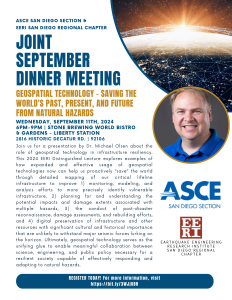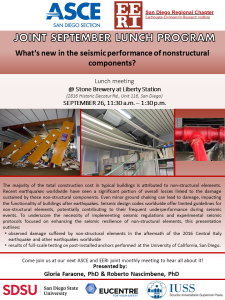7th Kenji Ishihara Colloquium Series on Earthquake Engineering
Fault Displacement
August 21st-22nd, 2025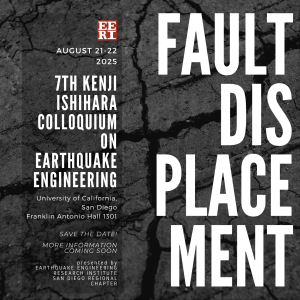
University of California, San Diego
Franklin Antonio Hall 1301
Save the date! The 7th Kenji Ishihara Colloquium will be in a couple of months on Fault Displacement. Stay tuned to receive updates on our program and registration.
Click the image on the right to view the save-the-date announcement.
PROGRAM
Coming soon!
VENUE
University of California, San Diego
Franklin Antonio Hall 1301
3180 Voigt Drive
La Jolla, CA 92093
REGISTRATION
Coming soon!
LODGING
Click here for a list of hotels near UCSD.
PARKING
There are two structures available for parking near Franklin Antonio Hall: Hopkins and Pangea. The closest parking structure to the venue is Hopkins Parking Structure (view here or here), located on Voigt Dr. off of Hopkins Dr. Please park on Level 7 (top floor – Parking Lot P347) where there are 92 visitor parking spaces. No other levels have visitor parking.
If Hopkins is full, please go to Pangea Parking Structure (view here or here), located on Pangea Dr. off of N. Torrey Pines Rd. Please park on Level 6 (top floor – Parking Lot P376) where there are 100 visitor parking spaces. The 5th floor only has 9 visitor parking spaces.
Parking can be paid for at a pay station within the structure, or through the ParkMobile app or website. More information can be found here.
Click image below to see the parking structures and venue highlighted (from https://maps.ucsd.edu/map/default.htm):
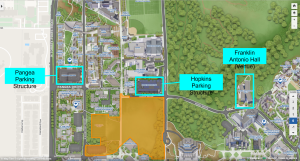
Click image below to see the parking structures and venue highlighted on Google Maps (from https://act.ucsd.edu/maps/):
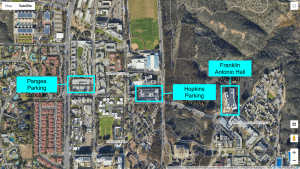
June 2025 Webinar
ISSUES ASSOCIATED WITH SIMPLIFIED PROCEDURES TO EVALUATE LIQUEFACTION TRIGGERING AND CONSEQUENCES
Wednesday, June 18th, 2025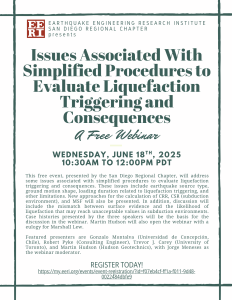
10:30am-12pm PDT
Virtual Event
This free webinar, presented by the San Diego Regional Chapter, will address some issues associated with simplified procedures to evaluate liquefaction triggering and consequences. These issues include earthquake source type, ground motion shape, loading duration related to liquefaction triggering, and other limitations. New approaches for the calculation of CRR, CSR (subduction environment) and MSF will also be presented. In addition, discussion will include the mismatch between surface evidence and the likelihood of liquefaction that may reach unacceptable values in subduction environments. Case histories presented by the three speakers will be the basis for the discussion in the webinar. Martin Hudson will also open the webinar with an eulogy for Marshall Lew.
Click the image to the right to view the event flyer.
REGISTRATION
Click here to register for the webinar. You do not need to be an EERI member to attend.
SPEAKERS
- Gonzalo Montalva, Universidad de Concepción, Chile; Liquefaction Triggering in Subduction Zones
- Robert Pyke, Consulting Engineer; The Limitations of Simplified Methods for Evaluating Earthquake-Induced Liquefaction and its Consequences
- Trevor J. Carey, University of Toronto; Toward Improved Magnitude Scaling in the Simplified Liquefaction Triggering Procedures
- Martin Hudson, Hudson Geotechnics
- Jorge Meneses, moderator
ASCE EERI September 2024 Joint Dinner Meeting
MEETING GEOSPATIAL TECHNOLOGY – SAVING THE WORLD’S PAST, PRESENT, AND FUTURE FROM NATURAL HAZARDS
Wednesday, September 11th, 2024
6pm-9pm
Stone Brewing Liberty Station
2816 Historic Decatur Road, Unit 116
San Diego, CA 92106
ASCE San Diego Section is co-hosting their September Meeting with EERI, featuring guest speaker Dr. Michael Olsen, 2024 EERI Distinguished Lecturer. Please join us at Stone Brewing to hear about the role of geospatial technologies in infrastructure resilience amidst natural hazards.
For members of EERI or ASCE = $40
For non-members = $50
For student members of EERI or ASCE = $30
For student non-members of EERI or ASCE = $40
Click the image to the right to view the event flyer.
REGISTRATION
Click here to register for the dinner.
Abstract
The task of maintaining resilient infrastructure against the onslaught of natural hazards often feels elusive and unattainable. Recent advances in technology offer promising solutions and opportunities towards this goal; however, the effective adoption and utilization of those technologies operates at a much slower pace given the societal realities of budget limitations, workforce shortages, polarization of priorities, disillusionment from past failures, and resistance to change. In day to day operations, efforts by engineers, planners, and decision makers often are stymied due to a lack of accessible, trustworthy, and current information related to infrastructure conditions. These problems are exacerbated in emergency situations where infrastructure systems and people are pushed to extreme limits.
At the project scale, inadequate site investigations result in substantial delays and cost-overruns from unanticipated problems during construction as well as poor infrastructure performance due to ground failure during a seismic event. These challenges propagate to the network scale where entities managing lifelines are often forced to make decisions prioritizing mitigation efforts based on limited, simplistic, or outdated information, which significantly hampers response and recovery efforts during a disastrous situation. This presentation explores examples of how expanded and effective usage of geospatial technologies now can help us proactively “save” the world through detailed mapping of our critical lifeline infrastructure to improve 1) monitoring, modeling, and analysis efforts to more precisely identify vulnerable infrastructure, 2) planning for and understanding the potential impacts and damage extents associated with multiple hazards, 3) the conduct of post-disaster reconnaissance, damage assessments, and rebuilding efforts, and 4) digital preservation of infrastructure and other resources with significant cultural and historical importance that are unlikely to withstand major seismic forces lurking on the horizon. Ultimately, geospatial technology serves as the unifying glue to enable meaningful collaboration between science, engineering, and public policy necessary for a resilient society capable of effectively responding and adapting to natural hazards.
Speaker Information: 6th Kenji Ishihara Colloquium Series on Earthquake Engineering
Punctuated Resilience, Climate Change and Bio-Geotechnics
Speakers and Abstracts
Alejandro Martinez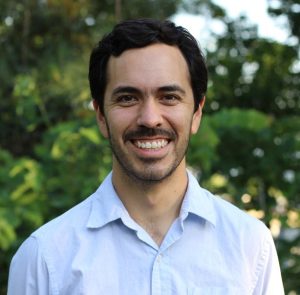
Associate Professor, University of California, Davis
Snakeskin-inspired piles and soil anchors: from bio-inspiration to field implementation
Abstract: Many aspects of the construction and performance of infrastructure rely on load transfer between soils and structures. Examples include deep foundations, soil anchors, and geosynthetics. This presentation will highlight the application of bioinspiration towards the transfer of load at soil-structure interfaces, with an emphasis on piled foundations and soil anchors. A dilemma in design exists: while large skin friction promotes a large capacity, it can also lead to difficulties during installation (i.e. refusal). To address this, surfaces with textures inspired by the belly scales of snakes were designed to assess the potential for mobilizing direction-dependent friction, and centrifuge and field load tests were performed to assess their effect the shaft capacity of piles and soil anchors. The laboratory, centrifuge, and field results reveal that greater skin friction is mobilized when the surfaces and piles are displaced in the cranial direction (i.e. soil moving against asperities) than when they are displaced in the caudal direction (i.e. soil moving along asperities). This direction-dependence is shown to be due to the greater soil deformation induced when the surfaces are displaced in the cranial direction. Cyclic interface shear tests and centrifuge load tests inform the degradation of skin friction mobilized by the bioinspired surfaces and piles. This presentation will discuss the potential benefits of the snakeskin-inspired surfaces in sites with sandy and clayey soils.
Bio: Alejandro Martinez is an associate professor at the University of California Davis. He obtained his Ph.D. and M.S. degrees from Georgia Tech in 2015 and 2012, respectively, and his B.S. from the University of Texas at Austin in 2010. His research aims to further the understanding of soil behavior and soil-inclusion interactions involved in geotechnical engineering. His research interests include bio-inspired geotechnics, soil-structure interactions, offshore geotechnics, and fabric effects on soil behavior. His research employs a combination of experimental laboratory, centrifuge modeling, and numerical techniques. In 2020, he received the NSF CAREER award and in 2022 he received the ASCE Arthur Casagrande Career Development Award.
Thomas O’Rourke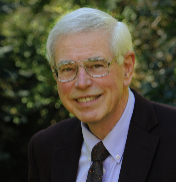
Thomas R. Briggs Professor of Engineering Emeritus, School of Civil and Environmental Engineering, Cornell University
Punctuated Resilience
Abstract: The concept of punctuated equilibrium, as advanced by Stephen Jay Gould and Niles Eldredge, is applied to infrastructure in this presentation. Professor O’Rourke will discuss how key infrastructure policies have been punctuated by hazards that affect the built environment. Just as the fossil record is composed of flash pictures that imply catastrophic change, so the record of hazards can provide a similar impression. Hazards that occurred once every generation, now occur almost yearly. Professor O’Rourke will explore how frequent hazards, such as hurricanes, affect resilience, and become a mechanism for improving the engineering and management of critical facilities. The agents of change that lead to improved policies and approaches are explored, including new technologies and the engagement of community support.
Bio: Tom O’Rourke is the Thomas R. Briggs Professor of Engineering Emeritus in the School of Civil and Environmental Engineering at Cornell University. He is a member of the US National Academy of Engineering, Distinguished Member of ASCE, International Fellow of the Royal Academy of Engineering, Member of the Mexican Academy of Engineering, and a Fellow of the American Association for the Advancement of Science. He authored or co-authored over 440 technical publications, and has received numerous awards for his research. His interests cover geotechnical engineering, earthquake engineering, underground construction technologies, engineering for large, geographically distributed systems, and geographic information technologies and database management.
J. Carlos Santamarina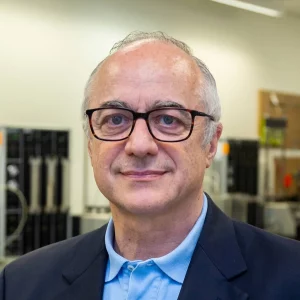
Professor & G. Wayne Clough Chair, Georgia Institute of Technology
The Energy-Climate-Livability Challenge: New Roles for the Earthquake Engineering Community
Abstract: Climate change is rapidly emerging as a significant threat to daily life, with profound implications for livability and the infrastructure. Caused by our reliance on fossil fuels, climate change affects water and food security, urban development, migration and consumption patterns, and policy at both national and international levels. The multifaceted consequences of the energy-climate-livability challenge are already testing vulnerabilities across all sectors, disproportionately affecting the most susceptible populations. The earthquake engineering community has a role to play in addressing these evolving challenges. Key areas include the seismic design of new and retrofitted civil infrastructure, the reimagined transportation systems, new onshore and offshore energy infrastructure (wind, solar, and storage systems – ranging from household to grid-scale), and mining operations for critical minerals essential for the energy transition. Special attention should be given to seismicity induced by energy projects (geothermal and hydraulic fracturing for oil and gas) and the interaction between more frequent extreme climatic events and seismic activity (e.g., more pronounced debris flows). Furthermore, the earthquake engineering community’s expertise with cyclic loading can be extended to the analysis of energy infrastructure subjected to low-amplitude repetitive loads, including storage systems, wind turbines, and thermally active components.
Bio: J. Carlos Santamarina (Professor and Clough Chair, Georgia Tech) earned his bachelor’s degree from the Universidad Nacional de Córdoba and completed graduate studies at the University of Maryland and Purdue University. Throughout his career, he has taught at NYU-Poly, the University of Waterloo, and King Abdullah University of Science and Technology. His research team utilizes a combination of experimental and numerical methods to investigate geomaterials (sediments, fractured rocks, and complex fluids) within the context of energy geo-science and engineering, from resource recovery to energy and waste geostorage. He delivered the50th Terzaghi Lecture on Energy Geotechnology and is a member of both Argentinean National Academies.
Christopher Wills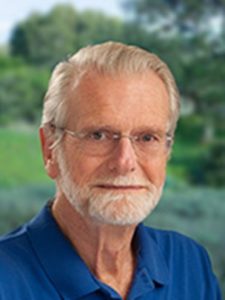
Professor Emeritus, University of California, San Diego
Punctuated Equilibrium and How It Works
Abstract: In 1972, Niles Eldredge and Stephen Jay Gould introduced the term “punctuated equilibrium” to describe the bursts of evolution that follow sudden major changes in the Earth’s environment, and the long periods of relative stasis that lay between these giant events. Now, we realize that many groups of organisms have managed to survive even the severest punctuations, and that waves of extinction have taken place even during periods of slower evolutionary change. Major extinction events do put severe stress on the entire biosphere, but we will see how Darwinian evolution enables life to recover from these stresses. The powerful process of evolution often takes life in new directions even without the aid of giant environmental disasters.
Bio: Born in England, Christopher Wills grew up in Canada. From1972 until his retirement in 2010 he was associate and full professor of biology at the University of California, San Diego. He was the first to deliberately select for genetic variants in enzymes. He has explored the roles of genetic recombination in the maintenance of genetic variation in Drosophila and yeast, and the role of microsatellite DNA variation in the evolution of diseases and the evolution of our species. Most recently, he has organized a large group of ecologists from around the world to apply new analytical methods to the forces that are maintaining variation in complex ecosystems such as rainforests and coral reefs. He has written nine books for the general public on evolution and ecology, the most recent being “Why Ecosystems Matter” (Oxford University press, 2024). In 1999, he received the Award for Public Understanding of Science and Technology from the American Association for the Advancement of Science.
6th Kenji Ishihara Colloquium Series on Earthquake Engineering
USGS Software Tools for Site-Specific Ground Motion Hazard Analysis
A Three-Quarter Day Short Course
Nicolas Luco, Supervisory Research Structural Engineer, U.S. Geological Survey
Peter Powers, Research Geophysicist, U.S. Geological Survey
Jorge F. Meneses, Senior Principal Geotechnical Engineer, Worley Consulting
Friday, September 13th, 2024, 8am-2:30pm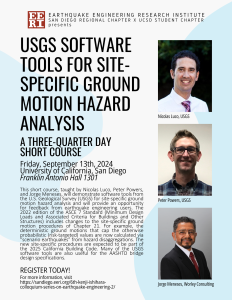
University of California, San Diego
Franklin Antonio Hall 1301
This short course will demonstrate software tools from the U.S. Geological Survey (USGS) for site-specific ground motion hazard analysis and will provide an opportunity for feedback from earthquake engineering users. The 2022 edition of the ASCE 7 Standard (Minimum Design Loads and Associated Criteria for Buildings and Other Structures) includes changes to the site-specific ground motion procedures of Chapter 21. For example, the deterministic ground motions that cap the otherwise probabilistic (risk-targeted) values are now calculated via “scenario earthquakes” from hazard disaggregations. The new site-specific procedures are expected to be part of the 2025 California Building Code. Many of the USGS software tools are also useful for the AASHTO bridge design specifications.
MEET THE INSTRUCTORS
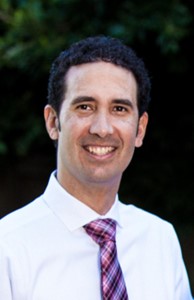
Dr. Nicolas Luco
Nico is a Supervisory Research Civil Engineer with the U.S. Geological Survey (USGS) at its Geologic Hazards Science Center in Golden, Colorado. There he serves as the Project Lead for the National Seismic Hazard Model, as of 2024. He also serves as a USGS Liaison on numerous external engineering committees that develop the seismic provisions of U.S. building codes, including the American Society of Civil Engineers (ASCE) Seismic Subcommittees for the ASCE 7 and 41 Standards. Prior to joining the USGS in 2004, he was a Senior Analysis Engineer with the insurance risk modeling company AIR Worldwide Corporation. He earned his PhD and BS in civil/structural engineering, and an MS in statistics, from Stanford University; his MS in civil/structural engineering is from the University of California, Berkeley.
Dr. Peter Powers
Peter Powers is a research and development geophysicist at the U.S. Geological Survey. Peter started his career as a geologist and worked in both the mining and tech sectors before attending the University of Southern California, from which he received a PhD in geophysics and seismology. He began his time at the USGS in 2008 as a Global Earthquake Model (GEM) post-doc and developer of OpenSHA and the Uniform California Earthquake Rupture Forecast version 3 (UCERF3). He now develops software and tools to support updates to USGS national hazard models and related research.
Dr. Jorge F. Meneses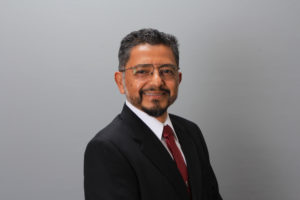
Dr. Jorge F. Meneses is a Senior Principal Geotechnical Engineer with Worley Consulting and has more than 30 years of consultancy, project management, research, and teaching experience, in both private industry and research institutions in the field of geotechnical and earthquake engineering. He has been involved in numerous projects serving as a technical lead in geotechnical earthquake engineering and foundation engineering across the country and various markets including water, nuclear, transportation, high rise buildings, energy, schools, hospitals, commercial and industrial. Dr. Meneses frequently acts as a peer reviewer for technical conferences and technical journal publications, is a guest speaker for domestic and international conferences, and has published more than 60 technical publications. He is currently a part-time faculty member in the graduate school of San Diego State University. He was the President and Founder of the Earthquake Engineering Research Institute (EERI) San Diego Chapter, California Seismic Safety Commissioner, Member of the EERI Board of Directors, Honorary Chair of the ASCE Geo-Institute San Diego Chapter, ex-Member of the ASCE 7-16 (Minimum Design Loads for Buildings and Other Structures), member of the ASCE 1 (Geotechnical Analysis, Design, Construction, Inspection and Monitoring of Nuclear Safety-Related Structures) and ASCE 7-28 Committees, member of the Academy of Geo-Professionals, member of the Academy of Geo-Professionals, and a Fellow of the American Society of Civil Engineers (ASCE).
PROGRAM
| Time | Topic/Speaker | |
|---|---|---|
| 8:00am | 9:00am | Registration and Breakfast |
| 9:00am | 9:15am | Welcome and Overview of Program |
| 9:15am | 9:45am | ASCE 7-22 Chapter 21 Site-Specific Ground Motion Procedures Jorge F. Meneses |
| 9:45am | 10:30am | USGS Application of Site-Specific Procedures for ASCE 7-22 Chapter 22 Ground Motion Maps Nicolas Luco |
| 10:30am | 10:45am | Break |
| 10:45am | 11:30am | Site-Specific Hazard Curves from USGS Earthquake Hazard Toolbox Peter Powers |
| 11:30am | 12:00pm | Updated USGS Risk-Targeted Ground Motion Calculator Nicolas Luco |
| 12:00pm | 1:00pm | Lunch |
| 1:00pm | 1:30pm | Site-Specific Disaggregations from USGS Earthquake Hazard Toolbox Peter Powers |
| 1:30pm | 2:00pm | Deterministic Response Spectra from USGS Earthquake Hazard Toolbox Peter Powers |
| 2:00pm | 2:30pm | Other Current and Future USGS Software Tools Peter Powers and Nicolas Luco |
VENUE
University of California, San Diego
Franklin Antonio Hall 1301
3180 Voigt Drive
La Jolla, CA 92093
REGISTRATION
Click here to register for the short course.
LODGING
Click here for a list of hotels near UCSD.
PARKING
There are two structures available for parking near Franklin Antonio Hall: Hopkins and Pangea. The closest parking structure to the venue is Hopkins Parking Structure (view here or here), located on Voigt Dr. off of Hopkins Dr. Please park on Level 7 (top floor – Parking Lot P347) where there are 92 visitor parking spaces. No other levels have visitor parking.
If Hopkins is full, please go to Pangea Parking Structure (view here or here), located on Pangea Dr. off of N. Torrey Pines Rd. Please park on Level 6 (top floor – Parking Lot P376) where there are 100 visitor parking spaces. The 5th floor only has 9 visitor parking spaces.
Parking can be paid for at a pay station within the structure, or through the ParkMobile app or website. More information can be found here.
Click image below to see the parking structures and venue highlighted (from https://maps.ucsd.edu/map/default.htm):

Click image below to see the parking structures and venue highlighted on Google Maps (from https://act.ucsd.edu/maps/):

6th Kenji Ishihara Colloquium Series on Earthquake Engineering
Punctuated Resilience, Climate Change, and Bio-Geotechnics | Next-Generation Liquefaction Modeling of Liquefaction Triggering and Surface Manifestation
Thursday, September 12th, 2024, 8am-5pm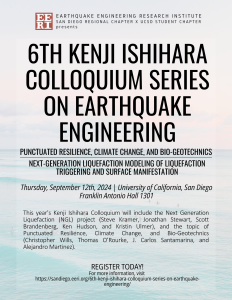
University of California, San Diego
Franklin Antonio Hall 1301
This year’s Kenji Ishihara Colloquium will include the Next Generation Liquefaction (NGL) project (Steve Kramer, Jonathan Stewart, Scott Brandenberg, Ken Hudson, and Kristin Ulmer) and the topic of Punctuated Resilience, Climate Change, and Bio-Geotechnics (Christopher Wills, Thomas O’Rourke, J. Carlos Santamarina, and Alejandro Martinez).
PROGRAM
Session 1: Punctuated Resilience, Climate Change, and Bio-Geotechnics
| 8:00am | 9:00am | Registration and Breakfast |
| 9:00am | 9:05am | Welcome and Overview of Program |
| 9:05am | 9:35am | Punctuated Equilibrium and How It Works Christopher Wills |
| 9:35am | 10:05am | Punctuated Resilience Thomas O'Rourke |
| 10:05am | 10:25am | Discussion |
| 10:25am | 10:40am | Break |
| 10:40am | 11:10am | Snakeskin-inspired piles and soil anchors: from bio-inspiration to field implementation Alejandro Martinez |
| 11:10am | 11:40am | The Energy-Climate-Livability Challenge: New Roles for the Earthquake Engineering Community J. Carlos Santamarina |
| 11:40am | 12:00pm | Discussion |
| 12:00pm | 1:00pm | Lunch |
Session 2: Next-Generation Liquefaction Modeling of Liquefaction Triggering and Surface Manifestation
| 1:00pm | 1:15pm | Project Overview and Database Overview John Stamatakos, Jonathan Stewart |
| 1:15pm | 1:40pm | Model Development Philosophy - Bayesian Framework Steven Kramer (Video) |
| 1:40pm | 2:05pm | Laboratory-Based Triggering Model Kristin Ulmer |
| 2:05pm | 2:30pm | Discussion |
| 2:30pm | 2:45pm | Break |
| 2:45pm | 3:20pm | Case History Processing Kenneth Hudson |
| 3:20pm | 3:45pm | Critique of Critical Layer Approach to Model Development Jonathan Stewart |
| 3:45pm | 4:00pm | Profile-Based Model Development Approach Scott Brandenberg |
| 4:00pm | 4:35pm | Proposed Manifestation and Triggering Models Kenneth Hudson |
| 4:35pm | 5:00pm | Discussion |
VENUE
University of California, San Diego
Franklin Antonio Hall 1301
3180 Voigt Drive
La Jolla, CA 92093
REGISTRATION
Click here to register for the colloquium.
LODGING
Click here for a list of hotels near UCSD.
PARKING
There are two structures available for parking near Franklin Antonio Hall: Hopkins and Pangea. The closest parking structure to the venue is Hopkins Parking Structure (view here or here), located on Voigt Dr. off of Hopkins Dr. Please park on Level 7 (top floor – Parking Lot P347) where there are 92 visitor parking spaces. No other levels have visitor parking.
If Hopkins is full, please go to Pangea Parking Structure (view here or here), located on Pangea Dr. off of N. Torrey Pines Rd. Please park on Level 6 (top floor – Parking Lot P376) where there are 100 visitor parking spaces. The 5th floor only has 9 visitor parking spaces.
Parking can be paid for at a pay station within the structure, or through the ParkMobile app or website. More information can be found here.
Click image below to see the parking structures and venue highlighted (from https://maps.ucsd.edu/map/default.htm):

Click image below to see the parking structures and venue highlighted on Google Maps (from https://act.ucsd.edu/maps/):

Speaker Information: 5th Kenji Ishihara Colloquium Series on Earthquake Engineering
Advancing Earthquake Engineering and Functional Recovery in the Wake of the Turkey Earthquake
Speakers and Abstracts
Tristan E. Buckreis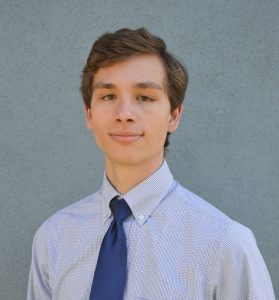
Postdoctoral Scholar, University of California, Los Angeles
Future Impacts of Ground Motions from the February 6, 2023 Türkiye Earthquake Sequence
Abstract: The 2023 Türkiye/Syria earthquake sequence is a once-in-a-century catastrophe, which includes the February 6 M7.8 mainshock followed approximately nine hours later by a M7.7 aftershock, and many smaller aftershocks. These events occurred in a region near the boundary of the Anatolian and Arabian plates (East Anatolian Fault), in the proximity of which numerous ground motion recordings sites had been installed north of the Türkiye/Syria border. As a result, the events were well recorded both near the fault where empirical databases generally lack observations, and at rupture distances up to 571 km. The repercussions of these events will have a lasting effect on the region, and their scientific and engineering impacts will prove to be influential for future ground motion related studies and efforts, such as the NGA-West3 project. In general, the data from this earthquake sequence will be useful for earthquake engineering applications, such as ground motion studies (e.g., ergodic and non-ergodic ground motion model, GMM, development), geotechnical studies (e.g., liquefaction), and structural dynamics. Preliminary spatial analyses of residuals have highlighted complex path effects in the region, likely related to differences in crustal properties between the Anatolian and Arabian plates. Since the events were well recorded over a wide distance range (0.6 – 571 km), the data produced from this sequence can be used to better capture these complex path effects. Furthermore, the M7.8 mainshock produced 25 usable records within 10 km of the rupture surface (38 within 25 km), which represents a magnitude-and-distance range of great interest to engineers. These near-source records are vital to ground motion studies of directivity and permanent-static displacements, and will also be used as input ground motions for response-history analysis of structures. It is the burden of the seismological and earthquake engineering communities to learn from this catastrophe to advance our knowledge and practice in order to mitigate the calamity of such events in the future.
Bio: Tristan E. Buckreis is a postdoctoral scholar in the Civil & Environmental Engineering Department at the University of California, Los Angeles (UCLA). He received his B.S. degree in Civil Engineering from California State University, Long Beach in 2017, and his M.S. and Ph.D. degrees in Civil Engineering (Geotechnical) from UCLA in 2018 and 2022, respectively. His area of expertise is in geotechnical earthquake engineering, with emphasis on ground motion characterization of regional path effects and local site response. His work also includes applications of microtremor-based horizontal-to-vertical spectral ratio (HVSR) in site response prediction, and curation and development of the NGA-West3 Project relational database.
Riccardo Cappa
Senior Consulting Engineer, Simpson Gumpertz & Heger (SGH)
Presentation Title Coming Soon!
Abstract: Coming soon!
Bio: Riccardo Cappa, Ph.D., P.E., has more than 10 years of professional experience in performance evaluation of power and water infrastructures. His academic research examined the seismic hazard and failure potential of levees in the Sacramento-San Joaquin Delta, California, through a combination of geotechnical centrifuge experiments and numerical studies. He is currently a Senior Consulting Engineer at SGH in the Newport Beach (CA) office and specializes in seismic probabilistic risk assessment methods for industrial and power generating plants, with a focus on nuclear power facilities. Riccardo has co-authored more than 30 papers and standards, including several research reports for the Electric Power Research Institute (EPRI). He has recently received the 2022 Heki Shibata early career award from the International Association for Structural Mechanics in Reactor Technology (IASMiRT) for his nuclear research and the 2022 Thomas Middlebrooks award from ASCE GI for his academic contribution to advancing the understanding of the seismic response of organic soils. He has collaborated with EPRI to develop improved equipment seismic capacities based on experience data and Bayesian inference, and has contributed to update and expand the SQUG online database, one of the largest collection of post-earthquake investigation data, including observations from 200+ large facilities subject to 35+ earthquakes. He has performed post-earthquake investigations of power and water infrastructures in Alaska (2018 M7.1), Ridgecrest (2019 M7.1), and Puerto Rico (2020 M6.4), and has recently led the EERI Lifelines reconnaissance team in Turkey following the February 2023 M7.8 earthquake.
Louise K. Comfort
Professor Emerita and Former Director, Center for Disaster Management, Graduate School of Public and International Affairs, University of Pittsburgh
The Gap Between Knowledge and Action: The 6 February 2023 Türkiye Earthquakes
Abstract: Coming soon!
Bio: Louise K. Comfort is professor emerita and former director, Center for Disaster Management, Graduate School of Public and International Affairs, University of Pittsburgh. She is a Visiting Researcher at the Policy Lab, Center for Information Technology Research in the Interest of Society (CITRIS), University of California, Berkeley. She is an elected fellow of the National Academy of Public Administration since 2006 and received the 2020 Fred Riggs Award for Lifetime Achievement from the Section on International Comparative Administration, American Society for Public Administration (SICA-ASPA). Her recent books include: Comfort, L.K. 2019 The Dynamics of Risk: Changing Technologies and Collective Action in Seismic Events, Princeton University Press; Comfort, L.K. and M. L. Rhodes, Eds. 2022. Global Risk Management: The Role of Collective Cognition in Response to COVID-19, Routledge Publishing; and Comfort, L.K. and H. P. Rahayu, Eds. 2023. Hazardous Seas: A Sociotechnical Framework for Early Tsunami Detection and Warning, Island Press. She has done field studies of 24 earthquake response systems in 14 countries, including a small social science reconnaissance study following the 6 February 2023 earthquakes in Türkiye. Her research focuses on decision making in response to natural hazards and other urgent events: earthquakes, hurricanes, tsunamis, wildfire, and COVID-19.
Rupa Garai
Senior Associate Principal, Skidmore, Owings & Merrill
Lessons Learned from Turkey Earthquake
Abstract: Coming soon!
Bio: Rupa Garai, P.E., S.E., LEED AP, is a Senior Associate Principal at Skidmore, Owings & Merrill, with 20+ years of experience in structural engineering services. She has lead the design of new and retrofitted structure, including mixed-use towers, commercial buildings, airports, courthouses, spec laboratories, education, residential, and office towers. Rupa is interested in exploring innovative concepts and ideas and is actively involved in the research and development of energy-dissipating technologies. She has published 25+ papers and is an active member of American Institute of Steel Construction (AISC) Technical Committee and BSSC 2026 Provisions Update Committee (PUC) and Issue Team (IT), where she chairs and co-chairs various committees.
Kit Miyamoto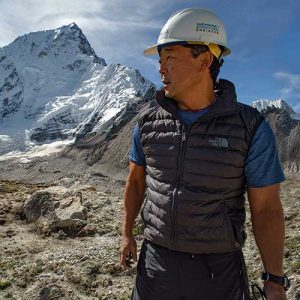
Global CEO, Miyamoto International, Inc.
2023 Türkiye Earthquake: State of the Art Rapid Assessment and Reconstruction of Damaged Structures to Reduce Internally Displaced Population
Abstract: 2023 Turkey earthquake caused 35,000 mid-rise buildings collapse, killed 51,000 people and 4.1 million people homeless. The program conducted by the largest municipality in the affected area, Gaziantep provided innovative rapid shelter solutions for Internally Displaced Population by assisting them in returning to repairable buildings.
Twenty-four hours immediate after earthquake, a team of international and Turkish engineers dispatched to understand damage context and assess ongoing emergency response and early recovery efforts. The Jet Proportion Lab (JPL) provided satellite data showing geographical point changes comparing pre and post-disaster imagery. This data was used to develop damage proxy maps for earthquake-affected cities and towns in the disaster impacted areas of southern Turkey and identify the areas for response attention. Using the remote satellite images, the urban areas within the damage zone was computed.
Next, the program provided technical assistance on cost-efficient, rapidly implementable repairs required to make light and moderate damaged building stock habitable. The program conducted state of art app-based vulnerability assessment surveys to identify the vulnerability classification and cost-efficient repair method based on locally available materials and labors for each damage type. BOQs and repair cost estimates generated enabled households to repair their homes rapidly. 3,100 structures were assessed, supporting an estimated 75,000 people.
Bio: Click here to read about Dr. Miyamoto.
Osman Ozbulut 
Associate Professor, University of Virginia
Bridging the Gap: Understanding Turkey’s February 6 Earthquake Ground Motions Through a Structural Lens
Abstract: The 2023 Kahramanmaraş earthquake sequence included two very high-magnitude earthquakes that occurred approximately 9 hours apart on neighboring fault lines, affecting a wide region in southeastern Türkiye. Not only did the seismic activity exceed expectations, but also the damage observed after these earthquakes surpassed all predictions. In this presentation, we will discuss the damage observed in reinforced concrete (RC) frame and shear wall buildings, as well as the performance of seismically isolated RC buildings. This discussion will take into account the seismic demands imposed on such structures, estimated from ground motion measurements obtained from the nearest seismic stations. We will also explore the effects of changes in seismic hazard maps and construction practices on the observed structural performance. The lessons learned from these events can be applied to the design and construction of future buildings, enhancing their resilience in the face of seismic activity and contributing to the overall safety of our built environment.
Bio: Osman Ozbulut is a Professor of Civil Engineering in the Department of Civil and Environmental Engineering at the University of Virginia. His research focuses on advancing a new generation of resilient and sustainable civil infrastructure through innovations in structural systems, materials, and sensing technologies. He has conducted extensive research on developing and characterizing shape memory alloy (SMA)-based self-centering passive energy dissipation and seismic isolation devices, aimed at mitigating damage and enhancing the post-event functionality of buildings exposed to seismic hazards. He is a member of the American Society of Civil Engineers (ASCE)Infrastructure Resilience Division (IRD) Emerging Technologies Committee, the ASCE Structural Engineering Institute(SEI) Seismic Effects Committee, and the Structural Control and Sensing Committee. Additionally, he serves as an Associate Editor for the Journal of Intelligent Material Systems & Structures, showcasing his commitment to advancing the field.
Grace Parker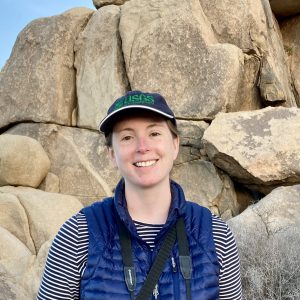
Research Geophysicist, United States Geological Survey Earthquake Science Center
Characterization of Source, Path and Site Effects on Ground Motions From the 2023 Kahramanmaraş, Türkiye, Earthquake Sequence
Abstract:We seek to understand the physical processes that generated the strong ground motions observed during the 2023 Kahramanmaraş, Türkiye, earthquake sequence, reasons why recorded motions may differ from existing ground motion models (GMMs), and factors controlling the observed variability. The devastating 2023 Türkiye earthquake sequence, including the M7.8 Pazarcik mainshock and the M7.5 Elbistan aftershock, occurred in the Eastern Anatolian Fault Zone. Because these destructive earthquakes represent an unprecedented set of near-source ground-motion records, understanding their genesis could improve GMMs and hazard estimates in Türkiye and worldwide. We perform an ensemble GMM residual analysis, examining ground motions from the 2023 sequence as well as other previous regional earthquakes, using a total of 63 M5+ events recorded on 1116 stations. Using many smaller earthquakes allows for robust sampling of source, site, and path effects, including consideration of more complex spatially varying and azimuth-dependent effects that we might expect to be present on a nationwide scale. We consider ground-motion residuals relative to the reference GMMs of Boore et al. (2014) and Kale et al. (2015) for spectral acceleration between 0.05s and 10s and peak ground motions. This talk will describe the partitioning and analysis of residuals into components representing repeatable source, path, and site effects towards understanding the relative contributions and physical implications of each.
Bio: Grace Parker is a research geophysicist at the USGS Earthquake Science Center. Her focus is understanding and modeling earthquake ground motions, with a special interest in seismic site response. She has developed models as a part of the NGA-East and NGA-Subduction projects that have been adopted for use in the USGS National Seismic Hazard Model. She is also involved in the USGS-led Shake Alert earthquake early warning project, where she works to determine the best real-time methods to estimate shaking intensities used to generate alerts. She holds a B.S. in Applied Geophysics and a Ph.D. in Civil Engineering from UCLA.
Esra Zengin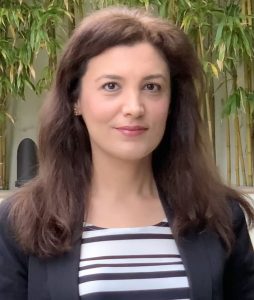
Senior Researcher, Natural Hazards Risk and Resiliency Research Center, University of California, Los Angeles
Investigation of Damage Potential of Ground Motions of the 6 February 2023 Pazarcik Turkey Earthquake by Developing Spatial Distribution of Inelastic Spectra
Coauthored by Yousef Bozorgnia, Aidin Tamhidi, Silvia Mazzoni
Abstract: On February 6, 2023, a devastating earthquake of magnitude 7.8 struck the southeastern part of Turkey, followed by a powerful aftershock with a magnitude of 7.7. Extensive damage in southern Turkey and northern Syria posed significant challenges for modern seismic design and existing structures’ resilience. This study primarily focused on evaluating the destructive potential of ground motions resulting from the Pazarcik mainshock, with a key emphasis on analyzing inelastic strength demand spectra. These spectra provide invaluable insights, particularly when considering the yield coefficient, denoted as “Cy”. The Cy represents the ratio between a structure’s yield strength (the point where it starts to undergo plastic deformation) and its total weight. In seismic design, engineers ensure the Cy value matches the desired ductility level, which characterizes a structure’s capacity to deform and absorb energy without failing. This Cy-ductility relationship is vital in creating earthquake-resistant buildings by balancing strength and ductility. Inelastic constant-ductility spectra were constructed by utilizing recording stations located within 100 km of the rupture distance (i.e., the closest distance to the fault plane). The results showed that, for structural periods of 0.5 seconds and 1.0 seconds, the Cy demand at a ductility level of 3 exceeded the Cy levels specified in the seismic design code for the 475-year return period, particularly when the rupture distance was less than 10 km. Given recorded ground motions, we generated time series for non-instrumented sites using a Gaussian Process Regression model (Tamhidi et al. 2023). Subsequent inelastic analyses were conducted, employing simulated ground motions to examine the variation in ductility demand across the area. The study concluded by comparing its outcomes with the observed damage patterns.
Bio: Dr. Esra Zengin holds a Ph.D. in Structural and Earthquake Engineering from Bogazici University, Istanbul, and received a B.S. degree in Civil Engineering from Middle East Technical University, Ankara, Turkey. She joined UCLA’s Natural Hazards Risk and Resiliency Research Center in 2022, following research positions at UC Davis and UC Berkeley, and a faculty position at Beykent University, Istanbul. Her research interests include characterization and modeling of ground motion, probabilistic seismic hazard analysis, seismic performance and risk assessment of structures.
Reid Zimmerman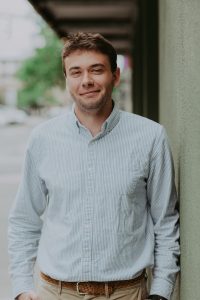
Technical Director, KPFF
Recovery Lessons for the U.S. in the Wake of the Kahramanmaraş Turkey Earthquake Sequence
Abstract: Southeastern Turkey and northern Syria were struck by two significant magnitude earthquakes on February 6th, 2023 that led to widespread severe building damage and collapse and an earthquake-affected area of 14 million people. Reid traveled to the earthquake-affected areas as part of an ASCE Structural Engineering Institute (SEI) team approximately seven weeks after the earthquakes. He will share his and the team’s observations from reconnaissance conducted over 10 days and more than eight cities, especially focusing on implications for recovery following a major earthquake in the U.S.
Bio: Reid Zimmerman is the Technical Director for the Portland, Oregon office of KPFF and has focused his career on advanced structural systems (e.g., seismic isolation, energy dissipation, rocking systems, etc.) and complex analytical techniques for assessing the effects of extreme hazards on structures. He is active in U.S. code development through ASCE 41, ASCE 7 and the Building Seismic Safety Council including chairing subcommittees on functional recovery and seismic isolation and energy dissipation.
Ali Sumer
Chief Intelligence Officer, Emergency Operations Center, California Department of Health Care Access and Information (HCAI)
2023 Turkiye Earthquake Sequence: Performance of Hospitals
Abstract: The 2023 Türkiye Earthquakes provide an unprecedented learning opportunity due to the strong earthquake shaking affecting modern engineered buildings. A hospital reconnaissance team, consisting of engineers from USA and Türkiye and a medical doctor from Türkiye, visited many hospitals in the earthquake area. The team collected structural and nonstructural data to identify what conditions allowed hospitals to continue to serve the community and which prevented the continuity of care. Of particular interest was learning the impediments to functional recovery.
Bio: Ali is the manager of hospital seismic retrofit program at California Department of Health Care Access and Information (formerly called OSHPD). He is a licensed structural engineer with a Ph.D. in Structural Engineering. He plays an active role on Emergency Operations Center at HCAI, acting as chief intelligence officer. Prior to joining the state, Ali worked in private industry for 9 years. He has performed several seismic retrofit projects, and has experience in performance-based design using nonlinear analysis techniques, building collapse risk analysis, and equipment shake table tests. He served as president of SEAOC Central. He is the co-creator of seismicmaps.org website to serve the engineering community.
5th Kenji Ishihara Colloquium Series on Earthquake Engineering
Advancing Earthquake Engineering and Functional Recovery in the Wake of the Turkey Earthquake
Join us for this free three-part webinar series on the lessons learned from the 2023 Kahramanmaraş, Turkey Earthquake Sequence. Researchers, expert engineers, and social scientists will come together in this Kenji Ishihara colloquium to discuss structural engineering and the far-reaching social implications of the Turkey earthquake sequence. Experts will share their insights on the lessons learned from the Turkey earthquake and how these are shaping the future of earthquake engineering, disaster preparedness, and response to enhance engineering practices and expedite seismic functional recovery.
Click image on right to view event flyer.
PROGRAM
Webinar #1: Thursday, October 5th, 2023, 11am-2pm PDT
Lessons Learned from Processing Ground Motions & Code Comparisons
Panelist 1 – Grace Parker, USGS Earthquake Science Center, Characterization of Source, Path and Site Effects on Ground Motions From the 2023 Kahramanmaraş, Türkiye, Earthquake Sequence
Panelist 2 – Tristan E. Buckreis, UCLA, Future Impacts of Ground Motions from the February 6, 2023 Türkiye Earthquake Sequence
Panelist 3 – Osman Ozbulut, University of Virginia, Bridging the Gap: Understanding Turkey’s February 6 Earthquake Ground Motions Through a Structural Lens
Panelist 4 – Esra Zengin, UCLA, Investigation of Damage Potential of Ground Motions of the 6 February 2023 Pazarcik Turkey Earthquake by Developing Spatial Distribution of Inelastic Spectra
Webinar 2: Thursday, October 12th, 2023, 11am-2pm PDT
Functional Recovery of Buildings
Panelist 1 – Ali Sumer, HCAI
Panelist 2 – Reid Zimmerman, KPFF, Recovery Lessons for the U.S. in the Wake of the Kahramanmaraş Turkey Earthquake Sequence
Functional Recovery of Lifelines
Panelist 3 – Riccardo Cappa, Simpson Gumpertz & Heger (SGH)
Panelist 4 – Ezra Jampole, Exponent
Panelist 5 – Rupa Garai, Skidmore, Owings, & Merrill, Lessons Learned from Turkey Earthquake
Webinar 3: Friday, October 27th, 2023, 11am-2pm PDT
Impacts to Social Recovery
Panelist 1 – Louise K. Comfort, University of Pittsburgh, The Gap Between Knowledge and Action: The 6 February 2023 Türkiye Earthquakes
Panelist 2 – Kit Miyamoto, Miyamoto International, Inc., 2023 Türkiye Earthquake: State of the Art Rapid Assessment and Reconstruction of Damaged Structures to Reduce Internally Displaced Population
REGISTRATION
Click here to register for the colloquium.
SDXEAA & EERI SD PE Seismic Design Workshop
Saturday, September 30th, 2023
9:45am-1:45pm
College-Rolando Branch Library
6600 Montezuma Road
San Diego, CA 92115
 San Diego Chi Epsilon Alumni Association (SDXEAA) is teaming up with EERI San Diego to co-host a free introductory workshop to seismic design for the California Seismic Principles Exam of the PE. Topics to be covered include spectral response, base shear, ASCE 7-16 seismic design criteria, and shear wall design, with example problems. This workshop will provide an overview of key concepts meant as a starting point for participants in their exam preparation. Light refreshments will be provided.
San Diego Chi Epsilon Alumni Association (SDXEAA) is teaming up with EERI San Diego to co-host a free introductory workshop to seismic design for the California Seismic Principles Exam of the PE. Topics to be covered include spectral response, base shear, ASCE 7-16 seismic design criteria, and shear wall design, with example problems. This workshop will provide an overview of key concepts meant as a starting point for participants in their exam preparation. Light refreshments will be provided.
This event is open to members of the public, including non-members of SDXEAA or EERI SD.
Click the image on the right to view the event flyer.
REGISTRATION
Click here to register for the workshop. Space is limited.
ASCE EERI Joint Luncheon 2023
WHAT’S NEW IN THE SEISMIC PERFORMANCE OF NONSTRUCTURAL COMPONENTS?
Tuesday, September 26th, 2023
11:30am-1:30pm
Stone Brewing Liberty Station
2816 Historic Decatur Road, Unit 116
San Diego, CA 92106
ASCE San Diego Section is co-hosting their September Lunch Program with EERI, featuring guest speakers Dr. Gloria Faraone, Assistant Professor at SDSU, and Dr. Roberto Nascimbene, Associate Professor at IUSS Pavia. The luncheon will review damage of non-structural elements from various international earthquakes, as well as results of post-installed anchors undergoing testing at UCSD.
For members of EERI and ASCE = $45.00
For non-members = $55.00
For public agency workers = $30.00
For more information, click the image to the right to view the event flyer.
REGISTRATION
Click here to register for the luncheon.
Registration is required as no walk-ins will be allowed.


